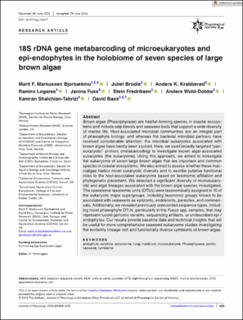18S rDNA gene metabarcoding of microeukaryotes and epi-endophytes in the holobiome of seven species of large brown algae
Bjorbækmo, Marit Frederikke Markussen; Brodie, Juliet; Krabberød, Anders Kristian; Logares, Ramiro; Fuss, Janina; Fredriksen, Stein; Wold-Dobbe, Anders; Shalchian-Tabrizi, Kamran; Bass, David
Peer reviewed, Journal article
Published version
Permanent lenke
https://hdl.handle.net/11250/3102667Utgivelsesdato
2023Metadata
Vis full innførselSamlinger
- Publikasjoner fra Cristin - NIVA [2170]
- Scientific publications [1177]
Sammendrag
Brown algae (Phaeophyceae) are habitat-forming species in coastal ecosystems and include kelp forests and seaweed beds that support a wide diversity of marine life. Host-associated microbial communities are an integral part of phaeophyte biology, and whereas the bacterial microbial partners have received considerable attention, the microbial eukaryotes associated with brown algae have hardly been studied. Here, we used broadly targeted “pan-eukaryotic” primers (metabarcoding) to investigate brown algal-associated eukaryotes (the eukaryome). Using this approach, we aimed to investigate the eukaryome of seven large brown algae that are important and common species in coastal ecosystems. We also aimed to assess whether these macroalgae harbor novel eukaryotic diversity and to ascribe putative functional roles to the host-associated eukaryome based on taxonomic affiliation and phylogenetic placement. We detected a significant diversity of microeukaryotic and algal lineages associated with the brown algal species investigated. The operational taxonomic units (OTUs) were taxonomically assigned to 10 of the eukaryotic major supergroups, including taxonomic groups known to be associated with seaweeds as epibionts, endobionts, parasites, and commensals. Additionally, we revealed previously unrecorded sequence types, including novel phaeophyte OTUs, particularly in the Fucus spp. samples, that may represent fucoid genomic variants, sequencing artifacts, or undescribed epi-/endophytes. Our results provide baseline data and technical insights that will be useful for more comprehensive seaweed eukaryome studies investigating the evidently lineage-rich and functionally diverse symbionts of brown algae.

